Stamps and many of the items found on these pages can be purchased from:-
 This is the second part of our New Zealand Wine Post collection, taking us over the second 10 years. This collection is complete at the moment but as new items, information or better images become available they will be added.
This is the second part of our New Zealand Wine Post collection, taking us over the second 10 years. This collection is complete at the moment but as new items, information or better images become available they will be added.The Wine Post, also known as New Zealand Wine Post, is a privately owned postal service in New Zealand. It is operated by Weston Winery New Zealand, which is the World's Most Southern Winery and acts as its only post office. It began issuing stamps for its own postage in 1990. It is one of the many independent posts of New Zealand which has a deregulated postal environment. The Wine Post stamps are for their domestic and international postage for their own winery.
Page One - New Zealand Wine Post 1990 - 1999.
Page Two - New Zealand Wine Post 2000 - 2009.
Page Three - New Zealand Wine Post 2010 - 2019.
Page Four - New Zealand Wine Post 2020 - 2029.
Special Page - New Zealand Wine Post - Official Stamps.
Special Page - New Zealand Wine Post - Wine Labels.
WP#23; WP#24.
1999/2000 - Turn of the Century- Commemorative.
Date of Issue - $1.00 Kiwi was issued 31st Dec 1999.
$1.50 Fern was issued 1st Jan 2000.
$1.00 - Kiwi & Globe. $1.50 - Silver Fern & Globe.
New Zealand was the first country in the world to see the new century and it was celebrated in style. Like NZ Post, the New Zealand Wine Post celebrated by issuing stamps the day before and the day after the turn of the century. The designs were similar, both featuring a globe with a map of New Zealand. Both stamps together are often known as the "Millennium Issue." The $1.00 showed a kiwi and was issued New Year Eve and the $1.50 showed a silver fern and was issued New Years Day.
These stamps were issued for local and New Zealand deliveries. They were issued in single denomination sheet blocks of four. The $1.00 Kiwi was issued Dec, 31st, 1999; the $1.50 Fern was issued Jan 1st, 2000.
Later they appeared in the Se-tenant format (Kiwi & Fern) as is most often seen.
2000 New Zealand Wine Post millennium cover with joined Se-tenant pair.
First Day Cover - 1st January 2000. There does not seem to be a First Day Cover for the kiwi by itself.

1999 - 2000 Postmarked. New Zealand Wine Post 'Millenium Issue 1999'. Notice the sharp cancel is the WineBird "World's Most Southern Winery" which is different to the special "Turn of the Century" First Day of Issue used on the cover above so it is most likely this stamp was not cancelled on January 1st, 2000. A fairly good example of this cancel strike can be found with the 2001 Chardonnay - Definitive further down this page.
Colour Trials.

1999/2000 issue. Turn of the Century. This is a unique imperforated colour trial of the kiwi and fern on ungummed paper. Notice that the Orange Kiwi and Yellow Fern are both semi-transparent in this trial while on the as issued stamps (see above), they appear bolder and opaque. The kiwi also had a colour change too.
2000 Turn of the Century - Se-Tenant sheetlet numbered.
The final layout of the miniature sheet was different from the trials above.
This is a rare special edition with the gold lettering above the sheet number.

1999 - 2000 Postmarked. New Zealand Wine Post 'Millenium Issue 1999'. Notice the sharp cancel is the WineBird "World's Most Southern Winery" which is different to the special "Turn of the Century" First Day of Issue used on the cover above so it is most likely this stamp was not cancelled on January 1st, 2000. A fairly good example of this cancel strike can be found with the 2001 Chardonnay - Definitive further down this page.
Colour Trials.

1999-2000 Turn of the Century proof sheet. Green Kiwi & Fern trial. While the kiwi is getting close to its final dark colour the green fern doesn't look good. It was at this point that the decision was made to break away from the natural colours which led to the next trial below.
2000 Turn of the Century - Se-Tenant sheetlet numbered.
The final layout of the miniature sheet was different from the trials above.
This is a rare special edition with the gold lettering above the sheet number.
WP#25; WP#26.
2000 - Air Export Issue.
Date of Issue - 1st Jan 2000.
$4 - Air Export to the USA. $5 - Air Export to the UK.
Two airmail stamps for shipments of export wine, one issued for destinations in the USA and the second issued for Great Britain. I think the designs speak for themselves using the national flags of each nation combined with a plane landing or taking off.
Hand Sketch - Artwork.
Here is something special, another of Geoff Westons' hand sketches done as a concept drawing before the design proceeds to the artwork stage. We love showing items like this so you can compare them with the final design. Notice how the aircraft is over on its side while in the final design it is flying in more level flight.
Two airmail stamps for shipments of export wine, one issued for destinations in the USA and the second issued for Great Britain. I think the designs speak for themselves using the national flags of each nation combined with a plane landing or taking off.
Hand Sketch - Artwork.
Here is something special, another of Geoff Westons' hand sketches done as a concept drawing before the design proceeds to the artwork stage. We love showing items like this so you can compare them with the final design. Notice how the aircraft is over on its side while in the final design it is flying in more level flight.
2001 Dunedin Railway Station - Local Definitive.
(Sunday Delivery)
Date of Issue - 4th May 2001.
2001 New Zealand Wine Post Sunday Post issue.
50c - Dunedin Railway Station.
(Issued for local deliveries.)
The Dunedin Railway Station is a fine example of Flemish Renaissance Revival architecture. The station is constructed of dark basalt from Kokonga in the Strath-Taieri region, with lighter Oamaru stone facings, giving it the distinctive light and dark pattern common to many of the grander buildings of Dunedin and Christchurch. A not to be missed attraction is the booking hall which features a mosaic floor of almost 750,000 Minton tiles.
It has been a popular subject on NZ Post stamps too, appearing at least 5 or 6 times.
First Day Cover showing Dunedin Railway Station.
It was a surprise when I saw this cover as I noticed there was an NZ Rail AB steam locomotive standing beside the station. (Seen on the right-hand side.) Now when you look back at the stamp you can see the locomotive there too.
(See our Dunedin Railway Station Collection.)
The Dunedin Railway Station is a fine example of Flemish Renaissance Revival architecture. The station is constructed of dark basalt from Kokonga in the Strath-Taieri region, with lighter Oamaru stone facings, giving it the distinctive light and dark pattern common to many of the grander buildings of Dunedin and Christchurch. A not to be missed attraction is the booking hall which features a mosaic floor of almost 750,000 Minton tiles.
It has been a popular subject on NZ Post stamps too, appearing at least 5 or 6 times.
First Day Cover showing Dunedin Railway Station.
It was a surprise when I saw this cover as I noticed there was an NZ Rail AB steam locomotive standing beside the station. (Seen on the right-hand side.) Now when you look back at the stamp you can see the locomotive there too.
(See our Dunedin Railway Station Collection.)
WP#28.
2001 Chardonnay Stamp - Definitive.
Date of Issue - 27th May 2001.
$1.00 - Wineglass containing Chardonnay.
A rather interesting design using reflections of firelight through a glass of clear chardonnay.
The stamp was issued for Local and New Zealand mail deliveries.
New Zealand Wine Post, 2001 Chardonnay imperf sheet. Part of the print run was on this thicker paper but many were never gummed or perforated.
Dated 2003, this is not an FDC but New Zealand Wine Post Paquebot envelope sent to the Solomon Islands Wine Post Agency. The stamps are two 2001 $1.00 Chardonnay dated both in New Zealand and at Honiara, Soloman Islands. Looking at the dates it appears this letter was cancelled in New Zealand on 5th August but was not cancelled again until 15 September. Notice the sharp, full example of the winebird cancel.
A rather interesting design using reflections of firelight through a glass of clear chardonnay.
The stamp was issued for Local and New Zealand mail deliveries.
New Zealand Wine Post, 2001 Chardonnay imperf sheet. Part of the print run was on this thicker paper but many were never gummed or perforated.
Dated 2003, this is not an FDC but New Zealand Wine Post Paquebot envelope sent to the Solomon Islands Wine Post Agency. The stamps are two 2001 $1.00 Chardonnay dated both in New Zealand and at Honiara, Soloman Islands. Looking at the dates it appears this letter was cancelled in New Zealand on 5th August but was not cancelled again until 15 September. Notice the sharp, full example of the winebird cancel.
WP#29.
2001 Air Export to Japan - Definitive.
Date of Issue - 27th May 2001.2001 Air Export to Japan - Definitive.
The design shows a plane, supposedly with wine exports, flying over that famous Japanese icon Mount Fujiyama. While being primarily issued for Wine Exports to Japan, it was also used for an Auckland/Tokyo P.O. service for transit documents where special official postmarks were applied in red and black/green, postmarked "Auckland/Tokyo."
2001 Japan Export the two overprints "Auckland/Tokyo" in red & black.
A lovely block of four Air Export to Japan.
It is rare to get blocks like this in many of the WinePost stamps as a shipment worth $16 would be a wine shipment sent to a customer where the used stamps would never be recovered. In this case, of course, the stamps are still mint (unused).
WP#30.
2001 First Conquerors of Mount Cook - Christmas Commemorate.
Date of Issue - 25th Dec 2001.
80c - Mountain Climbers - Conqueroring Mt Cook.
Issued on Christmas Day, 2001, to commemorate the first ascent of New Zealand's highest peak - Mount Cook in 1894. NZ WinePost claims that this is the first and only time this feat has ever been recognised on a postage stamp.
The first known ascent was on 25 December 1894, when New Zealanders Tom Fyfe, John Michael (Jack) Clarke and George Graham successfully reached the summit via the Hooker Valley and the north ridge. Despite an earlier failed attempt on 20 December, the local climbers were spurred on by their desire for the first ascent to be made by New Zealand mountaineers amid reports that the American mountaineer Edward FitzGerald had his eye on the summit.
2001 First Conquerors of Mt Cook - First Day Cover.
Nice view of Hooker Lake with Mount Cook/Aoraki in the background. This lake and the mountain would also appear again in a 2018 issue.
Nice view of Hooker Lake with Mount Cook/Aoraki in the background. This lake and the mountain would also appear again in a 2018 issue.
2001 Mount Cook Conquerors - part printing on the gummed side. The stamp pair above is a good example for comparison.
WP#31; WP#32.
2003 Dunedin Excursion Trains - Locomotives Definitives.
Date of Issue - 29th April 2003.
$2.00 - Diesel Locomotive. $2.00 - Steam Locomotive.
Ex NZR DJ Class. Ex NZR Ab Class.
We have found a number of good examples of the $2.00 Diesel Locomotive but have been unable to find any good examples of the $2.00 Steam Locomotive. In all the examples that we have seen, the steam locomotive is blackened out with no detail shown.
This image came from the cancel for this issue which used the same locomotive image. I have included this image as more detail of the locomotive can be seen.
$2.00 - Diesel Locomotive (Specimen). $2.00 - Diesel Locomotive (Missing Perf).
$2.00 - Diesel Locomotive (Used)
Loose used WinePost stamps are very hard to come by.
The Taieri Gorge Limited is New Zealand's longest tourist railway and stretches along the former Otago Central Railway from the 4 km peg on the Taieri Branch, 18 km west of Dunedin, to Middlemarch, a distance of some 60 kilometres. Between Dunedin and the start of the line, its trains operate on KiwiRail's Main South Line via a running rights agreement.
The line travels through spectacular scenery along the banks of the Taieri River, through numerous tunnels and climbing along the Taieri Gorge to the Strath Taieri. It crosses a dozen viaducts, including the southern hemisphere's largest wrought iron structure, and passes through ten tunnels. One of the key operations of this railway is to meet cruise liners, like the 'Sea Princess' shown behind the diesel locomotive, and take a trainload of passengers for the trip up the Taieri Gorge.
Full sheet showing both stamps.
Full sheet showing both stamps.
The Taieri Gorge Railway - First Day Cover.
Notice the sharp cancel complete with a steam locomotive. On the left-hand side, under the picture of the Diesel Locomotive is the image of an NZ Rail Freight Charge stamp. We have a full collection of these on our Railway Charge Stamps.
2005 Official registered cover to Wine Post Agency in Honiara, the Solomon Islands with special Butterfly cancel.
2003 WinePost Locomotive Definitives.
Paquebot Mail - First mail sent and received Honiara, Soloman Island.
Notice the sharp cancel complete with a steam locomotive. On the left-hand side, under the picture of the Diesel Locomotive is the image of an NZ Rail Freight Charge stamp. We have a full collection of these on our Railway Charge Stamps.
2005 Official registered cover to Wine Post Agency in Honiara, the Solomon Islands with special Butterfly cancel.
2003 WinePost Locomotive Definitives.
Paquebot Mail - First mail sent and received Honiara, Soloman Island.
WP#33; WP#34.
2003 Airmail Issues - Airmail Definitives.
Date of Issue - Hot Air Balloon 29th July 2003.
Vintage Aircraft 17th Dec 2003.
During 2003 The Winepost made two stamp issues to be used for the postage of documents, letters and small parcels. The first, with a picture of a hot air balloon that flew from Lafayette to New York. The second, featuring the aircraft used for the Wright Brothers First Flight.
$6.25 - Jupiter Hot-Air Balloon.
Flight from Lafayette, Indiana to New York.
The first official airmail delivery in the United States took place on August 17, 1859, when John Wise piloted a balloon starting in Lafayette, Indiana, with a destination of New York. Weather issues forced him to land in Crawfordsville, Indiana, and the mail reached its final destination via train.
$6.25 - Wright Brothers First Flight. The right stamp has an inscription on the top selvedge.
The Wright brothers, Orville and Wilbur, were two American brothers, inventors, and aviation pioneers who are credited with inventing and building the world's the first successful aeroplane and making the first controlled, powered and sustained heavier-than-air human flight, on December 17, 1903, four miles south of Kitty Hawk, North Carolina.
2003 New Zealand Wine Post airmail block of four with missing yellow colour. The block on the right is a normal example. Note that the error block still carries it sheet number in the selvedge.
New Zealand Wine Post Airmail from 2003. This strip of five stamps is a print trial to check the perforation gaps between the stamps. Five nice stamps in a strip all the same colour depth. The trial in imperforate, on ungummed paper.
A First Day Cover above also shows an actual photograph taken of the first Wright Brothers flight. That same photograph can be seen below.
The first flight, by Orville at 10:35 am, of 120 feet (37 m) in 12 seconds, at a speed of only 6.8 miles per hour (10.9 km/h) over the ground, was recorded in this famous photograph.
WP#35; WP#36; WP#37.
2004 New Zealand Birds - Definitives (Low values).
Date of Issue - 10th Aug 2004.
2004 New Zealand Birds - Definitives (Low values).
Date of Issue - 10th Aug 2004.
This issue of definitives, featuring birds endemic to New Zealand, is often divided into two groups due to their value. Endemic means- only found in New Zealand. Native means they also exist outside New Zealand. The lower 3 values were primarily used for mail and document postage. The larger four values were used primarily for shipments of wine.
The artwork from 1888 publication "A History of the Birds of New Zealand" watercolour paintings by the famous historic artist Sir Walter Lawry Buller.
New Zealand Fantail (Rhipidura fuliginosa)
The fantail is one of New Zealand’s best-known birds, with its distinctive fanned tail and loud song, and particularly because it often approaches within a metre or two of people. Its wide distribution and habitat preferences, including frequenting well-treed urban parks and gardens, means that most people encounter fantails occasionally. They can be quite confiding, continuing to nest build or visit their nestlings with food when people watch quietly. There are two colour forms or ‘morphs’ of the fantail, with the more common pied morph occurring throughout its range, and the black morph comprising up to 5% of the South Island population, and occasionally occur in the North Island.
2004 Post fantail colour trial for the Endemic Birds set. Grey Ghost colour shift
where the grey has shifted to the bottom-left.
Tui (Prosthemadera novaeseelandiae)
Tui is a boisterous, medium-sized, common and widespread bird of forest and suburbia – unless you live in Canterbury. They look black from a distance, but in good light, tui has a blue, green and bronze iridescent sheen, and distinctive white throat tufts (poi). They are usually very vocal, with a complicated mix of tuneful notes interspersed with coughs, grunts and wheezes. In flight, their bodies slant with the head higher than the tail, and their noisy whirring flight is interspersed with short glides.
This stamp is shown in our post How the Kiwi Lost His Wings.
Wood Pigeon (Hemiphaga novaeseelandiae).
This large and distinctively-coloured pigeon is a familiar sight to many New Zealanders. This is because the New Zealand pigeon (or kereru) has a widespread distribution through the country, being present in extensive tracts of native forest, and rural and urban habitats, including most cities. As well as allowing a close approach, it often roosts conspicuously, such as on power lines or on the tops of trees. The distinctive sound of its wingbeats in flight also draws attention. Kereru also frequently feature on works of art, such as paintings and sculptures. However, even though it is widespread, like many forest birds its abundance is severely compromised by introduced mammals, particularly possums, stoats and ship rats. Only where these pests are not present (predator-free islands) or are controlled to low levels do kereru populations thrive.
WP#38; WP#39; WP#40; WP#41.
2004 New Zealand Birds - Definitives (High values).
Date of Issue - 10th Aug 2004.
This issue of definitives is often divided into two groups due to their value. The lower 3 values were primarily used for mail and document postage. The large four values were used primarily for shipments of wine and were also used by Oceania Post, another local post run by The Winepost.
The artwork from 1888 publication "A History of the Birds of New Zealand" watercolour paintings by the famous historic artist Sir Walter Lawry Buller.
The blue duck or whio is an iconic species of clear fast-flowing rivers, now mostly confined to high altitude segments of rivers in North and South Island mountain regions. Nowhere common, it lives at low densities and its shrill “whio” whistle above the noise of turbulent waters will usher in a long-remembered encounter.
$15.00 - Kaka. $25.00 - Kingfisher.
Kaka (Nestor meridionalis)
Generally heard before they are seen, kaka are large, forest-dwelling parrots that are found on all three main islands of New Zealand and on several offshore islands. Much reduced in range and abundance in the North and South islands due to forest clearance and predation by introduced mammals, the kaka is most abundant on offshore islands that have no introduced mammals or at least no stoats. They remain locally common at some sites on the main islands that are close to offshore island refuges and have increased in abundance at others where mammalian pests have been controlled. Kaka can be found in a wide variety of native forest types including podocarp and beech forest. They are a common sight in Wellington city, having spread from Zealandia / Karori Sanctuary.
Kingfisher (Todiramphus sanctus),
The sacred kingfisher is one of the best-known birds in New Zealand due to the iconic photographs published over many years by Geoff Moon. These early images showed in detail the prey, the foraging skills and the development of chicks in the nest and as fledgelings. Equally recognisable is the hunched silhouette waiting patiently on a power line or other elevated perch over an estuary or mudflat which converts in a flash to a streak of green diving steeply to catch a prey item.
Kingfishers are found widely in New Zealand in a wide range of habitats: the key ingredients are elevated observation posts to hunt from, banks or suitable standing trees to excavate nests in, and open or semi-open habitats which support a range of prey items.
$50.00 - Albino Kaka.
Kaka (Nestor meridionalis)
See notes on Kaka above. Occasionally an albino parrot is seen, and this is called tuauru by the older Waiapu Maoris, who say that such birds make better decoys than do those of ordinary plumage, they attract their fellows better, possibly on account of their abnormal appearance. Also, albinos are said to be very good flock leaders.
First Day Cover with the four larger values.
The First Day of issue cover is cancelled with the Kingfisher postmark. It shows Se-tenant mini-sheet featuring all four stamps of this issue.
2004 Bird Definitives on a pictorial Cover.
Notice the original Winebird of 1990 is on the cancel of this cover.
Imperf proofs - notice the date under the bird name is missing on each of these stamps.
These stamps were never issued in this format, they were only placed like this for this colour trial so the stamps could be compared together.
The First Day of issue cover is cancelled with the Kingfisher postmark. It shows Se-tenant mini-sheet featuring all four stamps of this issue.
2004 Bird Definitives on a pictorial Cover.
Notice the original Winebird of 1990 is on the cancel of this cover.
Imperf proofs - notice the date under the bird name is missing on each of these stamps.
These stamps were never issued in this format, they were only placed like this for this colour trial so the stamps could be compared together.
WP#SP3a; WP#SP3b.
2004 Green Kiwi Officials.
Date of Issue - 18th Aug 2004.
95c - To HM Customs. 95c - To Parliament.
The Green Kiwis were produced for special official mail sent to either Parliament or HM Customs. The Parliament mail was important legal correspondence concerning Weston Winery or the future of the Wine Industry. The HM Customs letters were correspondence concerning the shipment of wine in and out of New Zealand and the payment of tax on wine produced.
New Zealand Wine Post green Kiwi Officials, "To Customs" and "To Parliament" overprints. Very rare to find in a joined se-tenant pair like this.
New Zealand Wine Post - Official Stamps.
New Zealand Wine Post green Kiwi Officials, "To Customs" and "To Parliament" overprints. Very rare to find in a joined se-tenant pair like this.
New Zealand Wine Post - Official Stamps.
WP#42; WP#43.
2005 15th Anniversary of New Zealand Wine Post.
(Commemorate)
2005 15th Anniversary of New Zealand Wine Post.
(Commemorate)
Date of Issue - 8th Aug 2005.
$2.50 - Mailman and Stamps.
The stamps shown are the 1990 Orange Winebird.
$4.35 - Harvest of Grapes.
It's the beginning of the harvest. A winemaker is inspecting the first basket of red grapes
before the picking begins.
Below is a full sheet of the $4.35 stamp.
This is a final printing proof. The black lines across the design prevent this stamps from being mistaken as issued stamps. I have not seen lines used like this before.
The blue value and other text are missing from the top of this stamp.
WP#EM1.
2006 NZ Wine Post Emergency Postage Provisional.
(Definitive)
Date of Issue - 10th Mar 2006.
Light Blue Provisional. Dark Blue Provisional.
These were printed in dark and light shades. The scarcer variety is the darker shade. They were also printed onto stationery (stationary types) with local delivery addresses, or without in singles or blocks and cancelled. Some uncancelled letters exist with and without addresses also. This stamp is one of two WinePost stamps which, due to emergency conditions, was issued without a special printed First Day Cover.
A "Specimen" example of the Emergency Postage Provisional.
2006 light blue printing Emergency Postage overprint block of four.
New Zealand Wine Post Emergency Postage 2006. Printed stamps postmarked on pieces cut from brown Postal wrappers. The destinations are major towns in Otago, New Zealand.
Left-hand - Undated imperforated Emergency Postage pair. The date was printed before the stamps were perforated. Well, that was the plan although it seems these stamps were never used at any other time.
Right-hand - A pair of the darker colour where the perforation has cut into the stamp design.
Here is another major perforation error.
This lower shift of the overprint occurred during a special trial printing.
WP#44.
2006 Wine to Europe - Definitive.
Date of Issue - 6th Dec 2006.
2006 Export Wine to Europe.
"New Zealand in a bottle."
2006 New Zealand Wine Post Wine To Europe proof printing. The design of the wine label from a bottle of Oak Chardonnay beside a map showing Europe and the UK makes for a simple yet effective design that tells us the stamp's main purpose.
2006 Export Wine to Europe First Day Cover.
2006 New Zealand Wine Post major perforation shift in
2006 Export Wine to Europe.
2006 Wine to Europe Airmail Cover. (Unused)
WP#45.
2007 Guinness Record - World's Most Southern Winery since 1995.
(Commemorative)
Date of Issue - 10th Oct 2007.
2007 New Zealand Wine Post 2007 Guinness Record stamp with selvedge.
The design shows The Guinness Logo with Weston Winery Buildings in the background.
2007 World Record rare block of four.- New Zealand Wine Post Issue.
World's Most Southern Winery - First Day Cover.
WP#46; WP#47; WP#48.
2007 Butterflies, Par-Avion & Export Definitives.
Date of Issue - 1st Oct 2007.
The 2007 Definitive issue was made up of five stamps, three general definitives showing butterflies and two airmail/export definitives showing Boeing 747 aircraft.
The three butterfly stamps were printed on the one sheet. The corner black above shows all three values with the issue title in the selvage above.
90c Red Admiral Butterfly. (Used)
Red Admiral Butterfly.
The New Zealand red admiral (Vanessa gonerilla) is a butterfly that is endemic to New Zealand. The Māori name is kahukura which means "red cloak". There are two sub-species, V. g. gonerilla, which occurs on the mainland of New Zealand, and V. g. ida, which occurs on the Chatham Islands.
It is a medium-sized butterfly with a 50–60 mm wingspan. The top side of the forewings is basically black with a central bright red bar running back from the front edge. There are white spots, fringed with light blue, near the tips. The rear wings are more a dark reddish-brown with a red area containing four black circles. The centre of each circle is pale blue. The underside of the rear wings is a mottled collection of shapes and white/brown/black colours – very camouflaged when at rest. When revealed, the underside of the forewings displays a striking blue eyespot bracketed by white and red arcs.
Monarch Butterfly.
The monarch butterfly or simply monarch (Danaus plexippus) are known for their annual fall migration, where monarchs cover thousands of miles south to Mexico. In New Zealand, they do not appear to migrate. The monarch’s wingspan ranges from 8.9 to 10.2 centimetres (3.5–4.0 in). The upper sides of the wings are tawny-orange, the veins and margins are black, and in the margins are two series of small white spots. Monarch forewings also have a few orange spots near their tips. The shape and colour of the wings change at the beginning of the migration and appear redder and more elongated than later migrants. The wings size and shape differ, between migratory and non-migratory monarchs.
In North America, the monarch ranges from southern Canada through northern South America. It has also been found in Bermuda, Cook Islands, Hawaii, Cuba and other Caribbean islands the Solomons, New Caledonia, New Zealand, Papua New Guinea, Australia, New Guinea, Sri Lanka, India, Nepal, the Azores, the Canary Islands, South Africa, Gibraltar, Philippines, North Africa and Honolulu. It appears in the UK in some years as an accidental migrant. No genetic differences between monarch populations exist. Reproductive isolation has not created subspecies.
$2.00 - Painted Lady Butterfly.
The Painted Lady (Vanessa kershawi) rarely exceeds 2" across its wings, and is known for the blue colouration at the centre of the four eyespots on its hindwings. Its body is dark brown, almost black, all over, except the tips of the antenna which are white. The base of the wings is brown, which turns into a brick-red colouration, broken by bands of black. The tips of the forewing are black with four white dots running from the apex of the wing, and a white bar extending from the leading edge of the forewing. The hindwings have four round eye-spots at their base, with a blue centre for at least three.
This butterfly is a native to Australia but during periods of large migration in Australia, and with the possible help of strong winds, the Australian painted lady migrates across the sea to New Zealand. Multiple occurrences of this butterfly in New Zealand were reported in the 1960s. While many were found along the western coastlines it is not known that any managed to breed and establish themselves here.
WP#49; WP#50.
$5.00 - Boeing 747 New Zealand. $20.00 - Boeing 747 World.
These two stamps in this issue were air mails stamps. They were different values reflecting domestic and overseas shipping rates. The $5.00 domestic stamp shows an overhead view Boeing 747 flying over New Zealand while the $20.00 international stamps show a side view of a Boeing 747 against a global map of the world.
2007 New Zealand Wine Post Export stamp with a flawed word in the selvedge.
Look more closely at the second "a" in Zealand.
$20.00 Boeing 747 World.
Double perforation flaw with the "a" flaw.
2013 special cover flown from Dunedin to Brisbane. The stamp is 2007 $5.00 - Boeing 747 over New Zealand complete with an NZ WinePost postmark/date stamp. The Postal Stationery is a light blue business envelope, small 165mm X 92mm. The Brisbane, Dunedin Airport logos can be seen on the left with the Virgin Australia logo and flight number below.
WP#51.
2008 Conquest of Everest 1953 - Commemorative.
Date of Issue - 20th Jun 2008.
$3.00 - Hillary & Tenzing.
Mount Everest, also known in Nepal as Sagarmāthā and in Tibet as Chomolungma, is Earth's highest mountain. It is located in the Mahalangur mountain range in Nepal and Tibet. Its peak is 8,848 metres (29,029 ft) above sea level.
In 1953, a British expedition, led by John Hunt, returned to Nepal. Hunt selected two climbing pairs to attempt to reach the summit. The first pair (Tom Bourdillon and Charles Evans) came within 100 m (330 ft) of the summit on 26 May 1953 but turned back after running into oxygen problems. Two days later, the expedition made its second and final assault on the summit with its second climbing pair, the New Zealander Edmund Hillary and Tenzing Norgay, a Nepali sherpa climber from Darjeeling, India. They reached the summit at 11:30 am local time on 29 May 1953 via the South Col Route. At the time, both acknowledged it as a team effort by the whole expedition, but Tenzing revealed a few years later that Hillary had put his foot on the summit first. They paused at the summit to take photographs and buried a few sweets and a small cross in the snow before descending.
2008 New Zealand Wine Post - First Day Cover.
Hillary and Tenzing summiting Mount Everest in 1953.
2008 New Zealand Wine Post daily letter with Hillary-Tenzing stamp postmarked.
2008 New Zealand Wine Post Hillary and Tenzing conquering Everest 2008 pair
showing the sheet number on the left and printers colour marks at the bottom.
New Zealand Wine Post numbered presentation card. 2008 Hillary & Tenzing imperforate vertical pair with the artwork. Specially printed and only issued for a mini-stamp exhibition in January 2014 at the Weston Winery post office.
Geoff Weston always has an eye for the collector and thematic market. This is a good example of that, using up older leftover stamps while creating a very marketable collector item.
Geoff Weston always has an eye for the collector and thematic market. This is a good example of that, using up older leftover stamps while creating a very marketable collector item.
2008 Kiwi - Silver Fern - Rejected Design.
A numbered presentation card showing a rather interesting design where a fern frond takes on a form of a kiwi. Notice the Southern Cross also appears in the top left corner. While this design was apparently rejected, I'm wondering if it might have been developed to make a great Official Stamp featuring three of the more famous emblems of New Zealand.
WP#52; WP#53.
2009 Free Postage & Fast Postage - Definitives.
Date of Issue - 28th May 2009.
Above are designing proofs of this issue.
$2.00 - Jaguar. $0.00 - Packard.
Below is a numbered display card showing the final stamp designs plus artwork.
Two examples of the stamps.
One of the more popular formats is to collect the se-tenant pairs as shown on the right
known as the 'collision pair' with the two cars heading towards each other. This format was so popular that it was used for the numbered display cards.
Imperf proof missing the yellow colour.
Notice the difference it makes to the colour of the car.
Stamps and many of the items found on these pages can be purchased from:-
Page One - New Zealand Wine Post 1990 - 1999.
Page Two - New Zealand Wine Post 2000 - 2009.
Page Four - New Zealand Wine Post 2020 - 2029.
Special Page - New Zealand Wine Post - Official Stamps.
Special Page - New Zealand Wine Post - Wine Labels.


















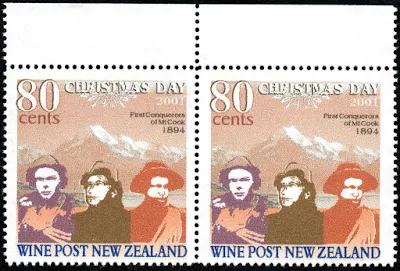


















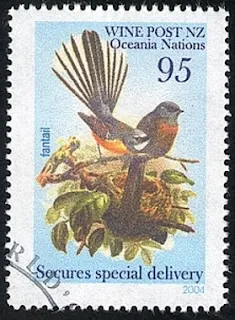














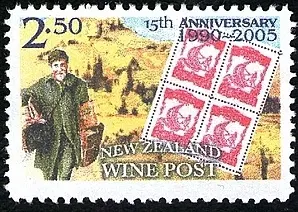







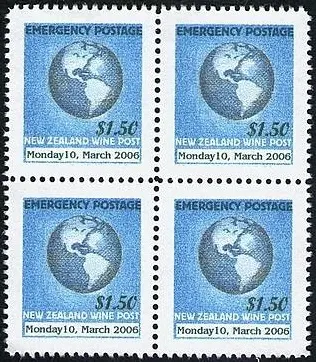


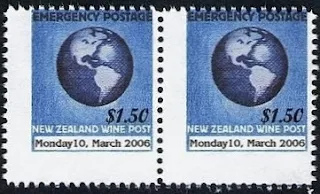


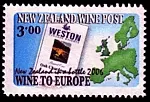






























We appreciate your engagement with our content. To ensure a respectful and constructive community, please take note of the following:
- No Spam, Please: We do not tolerate spammy or promotional comments. Any such comments will be promptly removed.
- Moderation in Place: All comments are moderated to maintain a positive and inclusive environment. Please be patient, as it may take a little time for your comment to appear.
- Sign In with Google: To comment, please sign in using your Google account. This helps us maintain the integrity of our community and allows for better interaction.